|
Rock Wall at the Practice Area
David Dore-Smith, Copperleaf Golf Club, Bonita Springs, FL:
 "It has already been a busy summer with various projects being undertaken throughout the property. Without question, the most visible enhancement to the golf course this year is the construction of a rock wall along the lake bank of the chipping and putting greens.
The project was conceived by the Green and Grounds Committee last year and approved during the budget process for completion in 2012. Once the golfing season had finished, the necessary permits from South Florida Water Management District and Lee County approved and the lakes were at their lowest level, work commenced in earnest.

Heavy equipment was rented to prepare the lake bank, transport the rocks from the maintenance facility and to finally position the rocks. Ricardo Gomez, one of our senior staff members who has assisted me with previous rock wall efforts in the past, was once again asked to help with the project. He operated a large front end loader with a rake attachment to cautiously move over 250 rocks to the practice area. An excavator, with a hydraulic 'thumb' attachment was then used to precariously position the rocks in their final resting position. I was fortunate to have received training on this equipment back in Australia many years ago and enjoy the challenge of operating such powerful machines.

There were 3 layers of rock used to produce the necessary height to match the level of the practice greens. Each layer had a cloth sheet placed behind it to help prevent erosion before being back-filled with soil.

Over 30 trucks of soil was needed to level the newly created area between the practice greens and the rock wall. Additional sprinklers were added by Irrigation Technician, Neil Johnson, to provide water to the area. Sod was cut from out of play areas throughout the course and was installed by Assistant Superintendent, Riaan Potgieter, with help from our own staff members. In all, the project was completed in two weeks. Besides an enhanced view from the clubhouse and hole 18, the rock wall will allow for an increased practice area for golfers and potentially allow for future improvements.

I can't thank my staff enough for the extra effort that it takes to complete such an immense project 'in-house'. Incredibly, the entire golf course had all cultural practices completed during this time by our staff members including aerification of all greens, fairways and roughs as well as double verti-cutting of all fairways and the clean up that comes with it. I hope that you are as proud of, and thankful for our staff as I am."
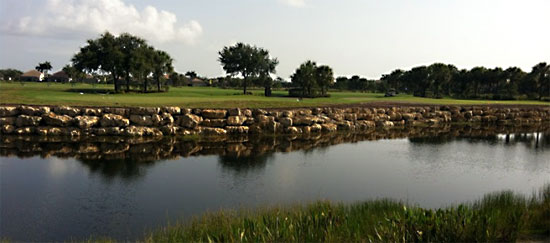
Visit David's blog at copperleafgcm.com.
|
 |
|
Renovation from A1/A4 to Champion Bermudagrass, Part 3...
Steven Harris, CGCS, Brier Creek Country Club, Raleigh, NC:
 "Tuesday, July 3: On Saturday afternoon I began seeing small green shoots and leaves emerging through the sand on the greens that were sprigged on Thursday. By Sunday evening every green on the course had leaves emerging. The hot weather is certainly helping to get the sprigs established quickly.
July 10: We are less than two weeks into the renovation to Champion bermudagrass on the greens and things are great! We began seeing new leaf emergence after just 3-4 days. Now, after only 12 days, the greens all have a very green look to them.
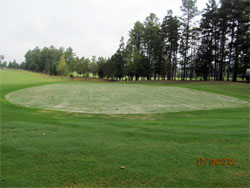
Just 12 days after planting.
|
The plan is for us to roll the greens tomorrow (weather depending) and several more times this week to try to smooth the surfaces out. We will continue to monitor the progress but could possibly have a mower out on the greens early next week! Once the mowers go out, this grass will start to spread and fill in very aggressively.
We have also begun our fertility plan for the grow in. In order to have the greens open in the 8 weeks, a heavy fertilizer program has been set in place. We will apply 2 lbs of nitrogen per 100 square feet until the greens are completely filled in and grown in. At that point we will begin backing off the nitrogen to make the plants stronger and start grooming the greens for play.
July 16: Time to mow! Today we put a mower on the new Champion bermudagrass greens for the first time. Only 17 days after sprigging the greens were dense enough and ready for a trim. We set the mowers at 0.200" and put solid rollers on the front of the mowers.
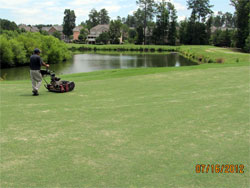 | 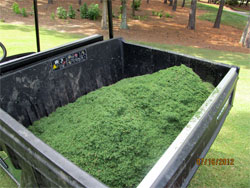 |
The next step will be to apply a very heavy topdressing to further smooth the surface and help level out some of the transitions along the edges. Once the topdressing is down, we will fertilize again and continue to roll. After this initial topdressing, we will begin to mow daily and gradually lower the heights down to get closer to a "normal" mowing height of 0.110"-0.125".
July 17: Birth of a Nursery Green: Nursery greens give you a place to harvest plugs or pieces of sod from in the event that an area of a green is damaged. Brier Creek has never had a nursery green. In the past, plugs and sod have been 'borrowed' from the practice putting green or the chipping green. This practice is unsightly and also affect the functionality of the practice areas.
"We finally decided on the unused tee on #2. The tee was abandoned many years ago due to houses being hit by golf balls..." |
When the decision was made to renovate the greens to Champion we felt that it was a good time to look for a site that we could use as a nursery. We finally decided on the unused tee on #2. The tee was abandoned many years ago due to houses being hit by golf balls every time the tee was used.
A former tee surface is a good location for a nursery because the tees are capped with 4-6" of greensmix sand at construction. This location will get plenty of sun, irrigation and make good use of some space that had been lost.
July 26: Half-way there! The Champion greens are really starting to fill in and look like a "green"! We are exactly halfway through the process today. Four weeks ago we began sprigging the greens and now, just four weeks later they are about 90% filled in.

We have been mowing for about 9 days now and have the mowing heigh down to 0.190" and plan to lower the height again tomorrow. We have been fertilizing heavily (2# Nitrogen per week) to really push the growth and speed the grow-in.
On Monday July 30th we will be aerifying the greens. This is an important step at this stage for a couple of reasons:
- Aerifying will help smooth the greens out. By punching a hole and removing a core it allows us to roll the greens while they are soft and flatten out any humps or dips that were created during the renovation process.
- While punching the holes we will be cutting the stolons (runners) of the plant. Doing this stimulates growth everywhere the stolon is cut and will produce more leaves that will quickly tiller over any voids that have not grown in yet.
- The aerification will help create a little softer green surface when they open later this summer. New greens tend to be very firm, this aerification will help alleviate that firmness.
August 2: Aerification.This past Monday and Tuesday we were able to successfully aerify all of the greens and topdress with sand. We used a 0.50" coring tine on a spacing of 2.5". This was enough to accomplish what we were looking to do but not so aggressive that we risked damaging the new greens.
Following aerification we rented a 1.5 ton asphalt roller to make the transitions from green to collar smoother and more playable. We then used our greens roller and rolled each green twice to smooth out and firm up the actual putting surface.
Once the greens were rolled and firmed up, we began topdressing them with sand. This will fill up the holes and provide channels for water and air to move into the roots to promote a good root structure.
After all of the sand was applied, the greens were dragged with a brush to move the sand into the holes. This process also moves sand around on the surface to help fill in low spots or voids to keep the surface smooth.
"The final three weeks of the renovation will be spent grooming the grass to be a great putting surface..." |
The aerification holes should be completely healed in about seven days. Once the holes are grown in, we will begin to shift our focus from 'Grow in' to grooming. The final three weeks of the renovation will be spent grooming the grass to be a great putting surface. We have already worked our mowing heights down from 0.200" to 0.170". We will continue to lower the heights every few days until we are at our final mowing height. This will be determined by plant health and green speed. We will also begin topdressing with a very fine sand that will really smooth out the surface and firm up the tops as well."
Visit Steven's blog at briercreekgcmaintenance.blogspot.com.
|
 |
|
Fat Sticks
Joel Kachmarek, Tacoma Country and Golf Club, Lakewood, WA:
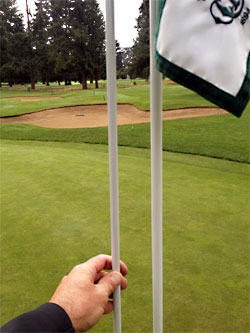  "I was playing golf yesterday (yes, that is unusual) and a member in my group, while putting from off the green, said "please pull the pin, those sticks are too fat". You see, at TC&GC we use a 5/8" diameter flagstick like the one on the right side of this picture. The flagstick on the left that I'm holding is a standard 1/2" diameter and certainly the most common. Why do we use the fatter flagstick? It's simple: they are better in windy conditions, more visible, and they feel nice and solid when you pick them up.
I said to the member, "do you realize how much extra we pay so that you can have these nice flagsticks"? He said, "I don't care how much they cost, because they're fat, they keep the ball from going in". Of course we all know that a flagstick never helps a ball go in, but now the question is maybe the fatter flagstick actually keeps the ball from going in. Ironically, later in the round the member holed out from 170 yards and I had the last laugh.
Lately we have had a lot of holes in one at Tacoma C&GC. So many, in fact, that I'm almost thinking the fatter flagstick helps the ball go in contrary to the belief of some of the members. It definitely got me thinking, so today I tried to answer that question.
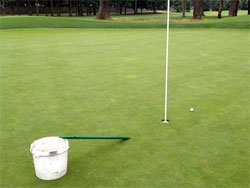 Here is the very complicated apparatus I created to assist me with the big question. Yes, it's a stimpmeter on a bucket. So today I rolled countless balls down the stimpmeter ramp from varying distances trying to simulate a ball striking the pin as it would from a golf shot. Not surprisingly, every ball that struck the pin squarely, went in. It went in every time on the 1/2" pin and every time on the 5/8" pin.
I tried to simulate the ball striking the pin NOT squarely. Now I was able to get some balls to hop out and not go in. They frequently did not go in on both of the two pins. Sometimes they dropped in, sometimes they did not. I finally found just the right angle to where the ball struck the pin NOT squarely but yet went in the cup every time on the 5/8" pin. That same angle resulted in some balls not going in on the 1/2" pin.
In the end, although there are many untested variables, I honestly feel that there is no statistical difference between the two pins and the incidence of hitting the pin and holing out. I still firmly believe that a flagstick never helped a ball go in, so I personally will continue to ask for the pin to be removed. But as for the question of whether a 5/8" pin keeps the ball form going in, there is no evidence to support that claim and in fact, I believe that the fatter stick actually helps the ball go in."
Visit Joel's blog at www.tacomaturf.com
|
 |
|
Back to Basics
Paul Chojnacky, Pasatiempo Golf Club, Santa Cruz, CA:
  "The past four years we have tried different systems to help members, guests, and outside play to determine hole locations on the greens. From the advanced plus (+) minus (-) system to determine how many paces from the center of the green to the four-quadrant rotational system, the daily course setup will revert to the old system of red, white, and blue flags. This will allow the maintenance crew the most flexibility in determining a hole location for the given day. It allows the staff to select the best possible location and will create more variety for those who play the course on a frequent basis.
This basic system is used frequently at many other golf courses and the colors represent the following:
RED – Front hole location
WHITE – Middle hole location
BLUE - Back hole location"
Visit Paul's blog at pasatiempomaintenance.com.
|
 |
|
If You Can Measure It...
John Slade, Laurel Creek Country Club, Mt. Laurel, NJ:
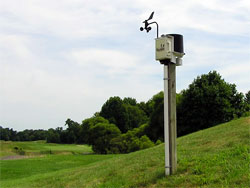  "...you can manage it. And today, thanks to some state of the art technology, we have many more ways to measure what's taking place on the golf course than in the past.
Like many people, we use weather radar to see when storms are approaching. Years ago, we had to have a satellite dish and subscription service to get this timely information about the weather. In contrast to that, today, anyone with a smart phone can quickly know when bad weather is about to hit the course.
Another piece of equipment we use daily is our on-site weather station. One of the important things this provides us is the evapotranspiration rate. As the name implies, this is the combination of moisture lost due to evaporation and transpiration.
"While the weather station is recording what's happening above the surface, we also have sensors underground that provide some key information..." |
While the weather station is recording what's happening above the surface, we also have sensors underground that provide some key information. Currently, sensors are located on #9 tee, #9 fairway, and #1 green. These measure soil temperature, moisture level and salinity at both a 2" and 8" depth. They then transmit this information wirelessly to a repeater which sends it to the golf course maintenance building. This information can be accessed from any place with an internet connection.
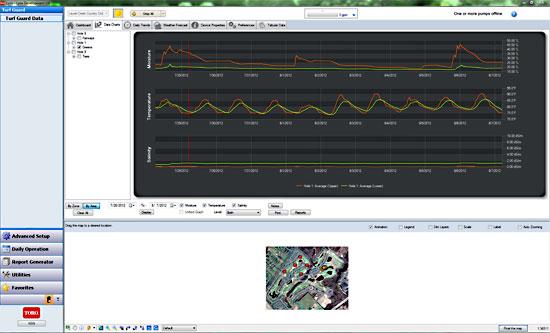
Temperature, moisture, and salinity from #1 green can be seen in this graph.
|
While we still make use of a good old soil probe on a regular basis, this high-tech equipment provides us with an enormous amount of information, allowing objective decision making with regard to proper timing and application of irrigation, plant protectants, and fertilization."
Visit John's blog at laurelcreeksuper.blogspot.com.
|
 |
|
Summer 2012
Rob Dorsch, CGCS, Richter Park Golf Course, Danbury, CT:
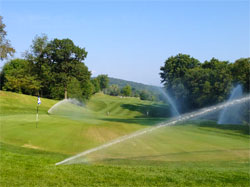 "Summer 2012 is on target to be the warmest ever in the Northeast. Our greens at Richter came through June and July with flying colors, the 1st week in August they started needing more TLC to make it through the final stretch. The stress on the greens is in direct relation to the intensity and duration of the heat we are experiencing this summer, along with limited air movement. The past week we have had zero air movement, 100% humidity and high temperatures. These three combinations are bad for turf that has exhausted all carbohydrates, have shallow roots and are screaming for cooler soil temperatures.
We are doing everything possible to keep everything going in the right direction. This week we performed some maintenance on most of our playing surfaces. Upon first glimpse it would appear that the we are rewinding back to 2011 on holes 6 and 7; this could be no further from the truth. We did indeed verticut and aerify this week and while we experienced some leaf bruising and thinning it is not critical in any way. The sand that is on the surface is there to protect the crown and encourage recovery in the form of upright growth. Initially I was hoping for the storms and cooler temps today; that is not going to happen and will delay recovery for a few more days. Brown is not bad; we have rolled the greens and it will not affect ball roll.
"We have created a culture where brown is bad, when actually it is good. In the future you will hear more about conservation and sustainability..." |
That last sentence is so very important. We have created a culture where brown is bad, when actually it is good. In the future you will hear more about conservation and sustainability. My long term goal is a conversion to 100% bent grass, losing some turf along the way (POA) is actually a good thing. We will manage to keep everything aesthetically pleasing, but if the opportunity presents itself to build our bent populations I am going to pounce."
Visit Rob's blog at richterparkturf.blogspot.com.
|
 |
|
Rescued Great Horned Owl Released!
Jason Hooper, Quilchena Golf Club, Quilchena, BC:
 "You may recall that an injured Great Horned Owl was rescued on the golf course about 3 1/2 months ago (see here). I'm pleased to announce the rescued owl has been completely rehabilitated and was released back onto the golf course on Tuesday evening.
The fine folks at OWL (http://www.owlcanada.ca/) provided great care for 'Tres', who received her name after being rescued on hole #3. She has a birth defect in the lenses of her eyes that makes it difficult for her to see clearly. She has been tagged and we will attempt to track her whereabouts and progress, that is if she chooses to continue to call Quilchena her home."
Visit Jason's blog at qgolfclub.blogspot.ca.
|
 |
|
About our Blog Aggregator: Many superintendents are now hosting private blogs to better communicate with their golfers and/or members. Beyond local weather and course conditions, there is a great deal of information about projects, methodologies and techniques that would be of value to other superintendents — hence our Turf Blog Aggregator. As every blogger struggles occasionally with content, we also include posts intended to educate golfers about turf maintenance for others to use as a template for their own blogs.
Miss any previous issues of TBA? You can find them all here.
Turf Blog Aggregator(TM) is a trademark of Turnstile Media Group.
|
|